Oriental-turtle-dove

Oriental Turtle Dove Streptopelia orientalis / S.o.agricola
Etymology:
- Streptopelia : Greek Word streptos-collar, neck-chain; peleia –dove
- Orientalis : From the Orient
- Agricola: Latin word ager-field; cola –dweller
Vernacular name: Hindi: Kalstet fakhta, Barko fakhta, Kali fakhta, Ghugghu, Kash: Wan kukil, Gugi, Jangli konkli, Kamir, Kamru, Pun: Kamloa, Ben: Ram ghughu, Ass: Harua kopou, Cachar: Daotu gajao, Naga: Inruiku, Kuki: Voh gura, Mani: Khunu chaphubi, Leima khunu, Guj: Shiyalu holi/holo, Te: Yedra poda guvva, Mal: Chengali pravu, Mar: Khavledar Hola
Distribution in India: Resident of North East, some parts of Central India and lower Himalayas, Summer visitor in upper Himalayas and Winter visitor in Central, West and North India
Description: Size of 32-33 cm. Forehead bluish grey merging into brownish grey with a rufous wash on nape and pinkish on face; throat pale buff merging into greyish pink on neck and breast; a black patch on side of neck, each feather tipped with grey; belly is pinkish buff, ventral regions whitish and under tail-coverts pale grey; hind neck dark grey feathers with rufous buff edgings; mantle feathers as on hind neck but with blackish centers to each; wing-coverts, scapulars and inner secondaries with dark centers more extensive; inner secondaries and scapulars edged with orange-buff or light chestnut; elsewhere feathers edged with bluish grey or feathers have black centers edged with pinkish fawn with a grey subterminal area; primaries black with pale edges; rump and underwing dark bluish grey; upper tail-coverts dark grey tipped with paler grey; central retrices blackish grey or dark brownish grey; outer retrices black with pale grey tips, web of outermost pale grey; iris shades of Red and orange, orbital skin dark purple or dark pinkish; bill mostly black, grey or dull purple but dark red or purplish at gape edges and base, pale horn coloured at tip; legs range from dark pink to reddish purple to purple. The female is duller on neck and breast; greyish pink of male replaced by salmony buff.
Habitat: It is found in a wide variety of habitats ranging from boreal to tropical forests.
Food Habits: It eats cereals and pine seeds; also herbs, bamboo shoots and green shoots of various plants. Feeding done on ground only.
Breeding Habits: They breed in May-Aug in North India and Nov-Feb in South India. They build a nest of twigs placed in a sapling, scrubby bush or bamboo clump. They lay a clutch of 2 eggs and incubation period is 15–16 days and fledging period is 15–17 days.